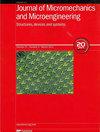Large Area Nanoscale Patterning of Functional Materials Using Organosilicate ink based Nanotransfer Printing
IF 2.1
4区 工程技术
Q2 ENGINEERING, ELECTRICAL & ELECTRONIC
引用次数: 0
Abstract
This paper presents a versatile nanotransfer printing method for achieving large-area sub-micron patterns of functional materials. Organosilicate ink formulations combined with effective release layers have been shown to facilitate patterning of materials through the commonly used patterning approaches – lift off, physical etching and chemical etching. In this paper, we demonstrate that organosilicate ink formulations function as an effective resist owing to its superior physico-chemical stability whereas the release layers ensure clean removal of the resist post patterning. We successfully demonstrate patterning of sub-micron structures (800 nm feature sizes) of chromium metal through the lift off approach, silicon through reactive ion etching technique and silicon dioxide through wet chemical etching technique illustrating the versatility of the reported method. This patterning methodology represents a significant advancement in enabling nanostructure fabrication within resource-constrained laboratories. The approach requires nothing more than a master mold containing the desired structures, a spin coater, a low-temperature hotplate, and a desktop reactive ion etch tool.利用基于有机硅油墨的纳米转移印花技术实现功能材料的大面积纳米级图案化
本文介绍了一种实现大面积亚微米功能材料图案的多功能纳米转移印刷方法。有机硅油墨配方与有效的剥离层相结合,已被证明可通过常用的图案化方法--掀起、物理蚀刻和化学蚀刻--促进材料的图案化。在本文中,我们展示了有机硅油墨配方因其卓越的物理化学稳定性而成为一种有效的抗蚀剂,而剥离层则可确保在图案化后干净地去除抗蚀剂。我们成功地演示了通过升降方法对亚微米结构(特征尺寸为 800 纳米)的金属铬、通过反应离子蚀刻技术对硅以及通过湿化学蚀刻技术对二氧化硅进行图案化,说明了所报告方法的多功能性。这种图案化方法是在资源有限的实验室内实现纳米结构制造的一大进步。这种方法只需要一个包含所需结构的母模、一个旋涂机、一个低温热板和一个台式反应离子刻蚀工具。
本文章由计算机程序翻译,如有差异,请以英文原文为准。
求助全文
约1分钟内获得全文
求助全文
来源期刊

Journal of Micromechanics and Microengineering
工程技术-材料科学:综合
CiteScore
4.50
自引率
4.30%
发文量
136
审稿时长
2.8 months
期刊介绍:
Journal of Micromechanics and Microengineering (JMM) primarily covers experimental work, however relevant modelling papers are considered where supported by experimental data.
The journal is focussed on all aspects of:
-nano- and micro- mechanical systems
-nano- and micro- electomechanical systems
-nano- and micro- electrical and mechatronic systems
-nano- and micro- engineering
-nano- and micro- scale science
Please note that we do not publish materials papers with no obvious application or link to nano- or micro-engineering.
Below are some examples of the topics that are included within the scope of the journal:
-MEMS and NEMS:
Including sensors, optical MEMS/NEMS, RF MEMS/NEMS, etc.
-Fabrication techniques and manufacturing:
Including micromachining, etching, lithography, deposition, patterning, self-assembly, 3d printing, inkjet printing.
-Packaging and Integration technologies.
-Materials, testing, and reliability.
-Micro- and nano-fluidics:
Including optofluidics, acoustofluidics, droplets, microreactors, organ-on-a-chip.
-Lab-on-a-chip and micro- and nano-total analysis systems.
-Biomedical systems and devices:
Including bio MEMS, biosensors, assays, organ-on-a-chip, drug delivery, cells, biointerfaces.
-Energy and power:
Including power MEMS/NEMS, energy harvesters, actuators, microbatteries.
-Electronics:
Including flexible electronics, wearable electronics, interface electronics.
-Optical systems.
-Robotics.
 求助内容:
求助内容: 应助结果提醒方式:
应助结果提醒方式:


